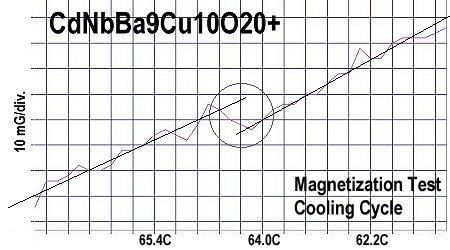
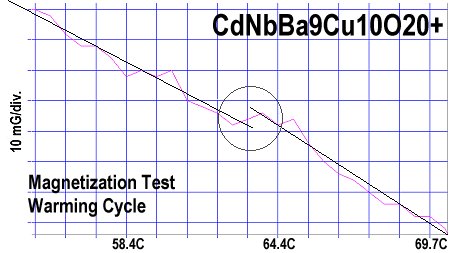


Superconductors.ORG herein reports high Tc for copper-chain superconductors has been advanced by exploiting a high-dielectric-constant anion in the target F212C structure shown below left. A small amount of the compound CdNbBa9Cu10O20+ has been found to produce a critical transition temperature (Tc) near 64 Celsius (147F/337K) both resistively and magnetically[1], making it the 35th room-temperature superconductor discovered to date[2]. Cooling and heating magnetization plots are posted at page top showing Meissner transitions of about 8-15 milliGauss. [The straight lines represent the average of the data points, skewing apart at Tc.]
The previous record for high Tc among copper-chain structures was 58C for TiBa9Cu10O20+. While traditional cadmium pyroniobate
(Cd2Nb2O7) has a different
chemical formula than what forms in this F212C structure, the dielectric constant (Kappa) is nonetheless increased sufficiently to outperform all other known copper-chain superconductors.
More than a dozen direct resistance tests produced transitions ranging from 63C to 65.5C. The lowest and highest of these tests are shown below.
The first copper-chain formulation to attain room-temperature superconductivity was ZrBa9Cu10O20+ (Tc=49C), discovered in July 2015. It was quickly followed by TaBa9Cu10O20+ (Tc=40C), NbBa9Cu10O20+ (Tc=40C) and VBa9Cu10O20+ (Tc=54C) in August.
And then Y2Ba10Cu12O25+ (Tc=33C) and TiBa9Cu10O20+ (Tc=58C) came in November. As with non-chain-type copper-oxides, Tc advanced
through increased planar weight disparity across the oxygen layers that separate the anion from cation layers (the light/heavy interface at left). Tc also improves when high Kappa compounds are incorporated into a given structure. These have included TaO, TiO, MnO, SnSb, SnTe, and now CdNbO.
Note in the target structure at left that the Cd and Nb atoms
are offset, rather than collinear along the C axis. This is necessary to juxtapose the CdNb anion with oxygen at the apices of the CuO pyramid base. It may be possible to achieve a similar Kappa increase with a non-planar arrangement.
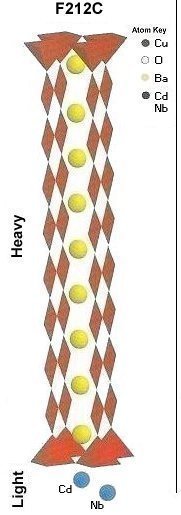
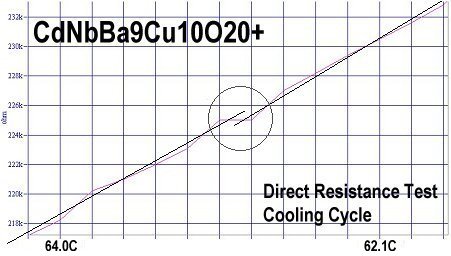
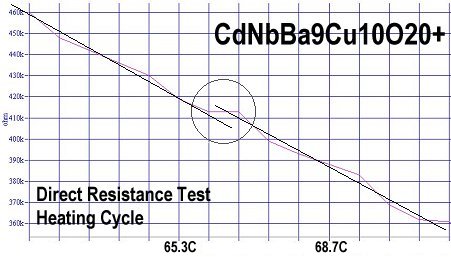
The below graph of known copper-chain superconductors illustrates the correlation between planar weight ratio and Tc in these materials. It also confirms the strong influence that dielectric constant (K) has in promoting Tc. CdNb9A has the highest anion Kappa[3], raising its Tc well above the others on the graph.
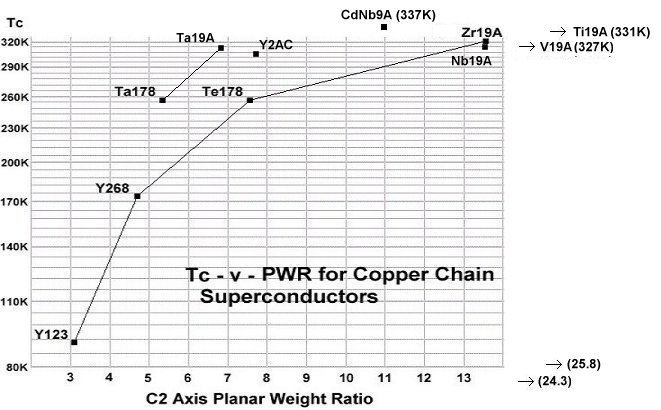
In order to maximize formation of the F212C structure, CdNbBa9Cu10O20+ was synthesized using the layer cake method, as shown below. The pellet had approximately 100 interference layers. And, even using this layering technique, the volume fraction is low, requiring very sensitive test equipment.
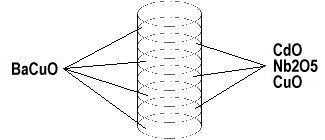
Stoichiometric ratios of the below chemicals were used for the ODD layers:
BaCuO 99.9% (Alfa Aesar) 15.25 grains...and the below ratios for the EVEN layers.
CdO 99.998% (Alfa Aesar) 1.00 grainThe chemical precursors were pelletized at 60,000 PSI and calcined for one-half hour at 760C and then sintered for 12 hours at 880C. Lastly the pellet was annealed for 8+ hours at 500C in flowing O2. Temperature was determined using an Omega type "T" thermocouple and precision OP77 DC amplifier. The magnetometer employed twin Honeywell SS94A1F Hall-effect sensors with a tandem sensitivity of 50 mv/Gauss.
RESEARCH NOTE: The copper-oxides are strongly hygroscopic. All tests should be performed immediately after annealing.
RE-PUBLICATION NOTICE: Elsevier Publishing, dba Elsevier Science, as well as Morris Communications, both print and broadcast divisions, are specifically prohibited from re-publishing any part of this news story.
E. Joe Eck
© 2016 Superconductors.ORG
All rights reserved.
1. Testing temperatures are believed accurate within ± 0.5 degrees C.
2. For a complete list of all 35, click HERE.
3. Dielectric constants were obtained from H. P. R. Frederikse, CRC Handbook of Chemistry and Physics.
 BACK to "News" page at Superconductors.ORG
BACK to "News" page at Superconductors.ORG